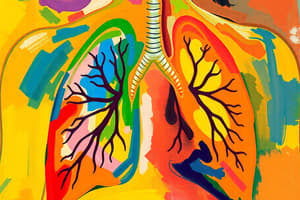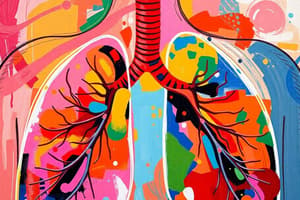Podcast
Questions and Answers
What primarily drives the process of inspiration?
What primarily drives the process of inspiration?
Expiration is always an active process that requires energy.
Expiration is always an active process that requires energy.
False (B)
What is the primary form in which carbon dioxide is transported in the blood?
What is the primary form in which carbon dioxide is transported in the blood?
Bicarbonate ions
Gas exchange occurs across the thin __________ in the alveoli of the lungs.
Gas exchange occurs across the thin __________ in the alveoli of the lungs.
Signup and view all the answers
Match the respiratory terms with their descriptions:
Match the respiratory terms with their descriptions:
Signup and view all the answers
What response occurs when CO2 levels rise in the blood?
What response occurs when CO2 levels rise in the blood?
Signup and view all the answers
Increased pH levels indicate that breathing should be stimulated.
Increased pH levels indicate that breathing should be stimulated.
Signup and view all the answers
Name one condition that can affect breathing and gas exchange.
Name one condition that can affect breathing and gas exchange.
Signup and view all the answers
The condition known as __________ involves constriction of the airways, leading to difficulty in breathing.
The condition known as __________ involves constriction of the airways, leading to difficulty in breathing.
Signup and view all the answers
Match the respiratory disorders with their descriptions:
Match the respiratory disorders with their descriptions:
Signup and view all the answers
What is the primary function of the alveoli in the lungs?
What is the primary function of the alveoli in the lungs?
Signup and view all the answers
What role do chemoreceptors play in the regulation of breathing?
What role do chemoreceptors play in the regulation of breathing?
Signup and view all the answers
Which of the following best describes diffusion in gas exchange?
Which of the following best describes diffusion in gas exchange?
Signup and view all the answers
Which factor is NOT considered critical for efficient gas exchange in the lungs?
Which factor is NOT considered critical for efficient gas exchange in the lungs?
Signup and view all the answers
In what way does chronic obstructive pulmonary disease (COPD) typically affect gas exchange?
In what way does chronic obstructive pulmonary disease (COPD) typically affect gas exchange?
Signup and view all the answers
Which structure is primarily involved in the transition of air between the pharynx and lungs?
Which structure is primarily involved in the transition of air between the pharynx and lungs?
Signup and view all the answers
What triggers adjustments in the breathing rate and depth according to blood chemistry?
What triggers adjustments in the breathing rate and depth according to blood chemistry?
Signup and view all the answers
What is a common effect of asthma on the respiratory system?
What is a common effect of asthma on the respiratory system?
Signup and view all the answers
How does the process of expiration differ from inspiration?
How does the process of expiration differ from inspiration?
Signup and view all the answers
Flashcards
Pulmonary Ventilation
Pulmonary Ventilation
The process of moving air into and out of the lungs, involving inspiration (inhaling) and expiration (exhaling).
Gas Exchange
Gas Exchange
The movement of oxygen from the air into the bloodstream and carbon dioxide from the bloodstream into the air. It occurs across the thin respiratory membrane in the alveoli.
Partial Pressures
Partial Pressures
The difference in oxygen and carbon dioxide partial pressures between the alveoli and the blood. This drives diffusion of gases across the respiratory membrane.
Oxygen Transport
Oxygen Transport
Signup and view all the flashcards
Control of Respiration
Control of Respiration
Signup and view all the flashcards
Chemoreceptors in respiratory control
Chemoreceptors in respiratory control
Signup and view all the flashcards
Respiratory response to high CO2
Respiratory response to high CO2
Signup and view all the flashcards
Respiratory response to low CO2
Respiratory response to low CO2
Signup and view all the flashcards
Respiratory Disorders
Respiratory Disorders
Signup and view all the flashcards
Asthma
Asthma
Signup and view all the flashcards
What is gas exchange?
What is gas exchange?
Signup and view all the flashcards
What are the key organs of the respiratory system?
What are the key organs of the respiratory system?
Signup and view all the flashcards
How does breathing work?
How does breathing work?
Signup and view all the flashcards
Why are alveoli important for gas exchange?
Why are alveoli important for gas exchange?
Signup and view all the flashcards
What drives gas exchange at the alveoli?
What drives gas exchange at the alveoli?
Signup and view all the flashcards
What factors affect gas exchange efficiency?
What factors affect gas exchange efficiency?
Signup and view all the flashcards
How is breathing regulated?
How is breathing regulated?
Signup and view all the flashcards
What are chemoreceptors in breathing
What are chemoreceptors in breathing
Signup and view all the flashcards
What conditions can affect the respiratory system?
What conditions can affect the respiratory system?
Signup and view all the flashcards
How is oxygen transported in the blood?
How is oxygen transported in the blood?
Signup and view all the flashcards
Study Notes
Pulmonary Ventilation
- Breathing, or pulmonary ventilation, is the mechanical process of moving air into and out of the lungs.
- It involves two phases: inspiration (inhaling) and expiration (exhaling).
- Inspiration is an active process driven by the diaphragm and external intercostal muscles. These muscles contract, expanding the thoracic cavity, which lowers the pressure within the lungs, drawing air in.
- Expiration is typically a passive process. Relaxation of the diaphragm and intercostal muscles allows the elastic recoil of the lungs and chest wall to push air out.
- During forced breathing, accessory muscles like the sternocleidomastoid and pectoralis minor assist in deeper inhalation and exhalation. Pressure changes within the lungs drive these processes.
Gas Exchange
- Gas exchange is the movement of oxygen (O2) from the air into the bloodstream and the movement of carbon dioxide (CO2) from the bloodstream into the air.
- This occurs across the thin respiratory membrane in the alveoli of the lungs.
- Oxygen diffuses from the alveoli into the capillaries surrounding them, due to a difference in partial pressures.
- Carbon dioxide diffuses from the capillaries into the alveoli, also due to a pressure gradient. Alveoli are tiny air sacs with a large surface area, facilitating efficient gas exchange.
Factors Affecting Gas Exchange
- Partial pressures: The difference in oxygen and carbon dioxide partial pressures between the alveoli and the blood drives the diffusion process.
- Surface area: The large surface area of the alveoli (tiny air sacs) maximizes gas exchange efficiency.
- Distance: The very thin respiratory membrane minimizes diffusion distance facilitating rapid exchange.
- Solubility: Gases dissolve into liquid more readily when their solubility is high. Oxygen has a low solubility in liquid water. Hemoglobin facilitates its transport.
- Ventilation-perfusion coupling: Efficient gas exchange depends on matching the rate of air flow (ventilation) to blood flow (perfusion) in the lungs.
- Permeability: The permeability of the respiratory membrane impacts gas exchange rates.
- Blood flow: Blood flow in the capillaries and the rate of air movement are also important for efficient gas exchange.
Transport of Gases
- Oxygen transport: Oxygen is primarily transported bound to hemoglobin within red blood cells. This increases the amount of oxygen that can be carried in the blood. Higher hemoglobin concentration enhances oxygen transport.
- Carbon dioxide transport: Carbon dioxide is transported in the blood in three forms: dissolved in plasma, bound to hemoglobin, and as bicarbonate ions. The bicarbonate form is the most significant.
Control of Respiration
- The respiratory center in the medulla oblongata of the brain regulates breathing.
- This center responds to changes in blood CO2 levels, oxygen levels, and pH.
- Chemoreceptors in the carotid and aortic bodies sense these changes and signal the respiratory center accordingly.
- When CO2 levels rise or pH decreases (acidosis), breathing rate is stimulated to eliminate CO2 and restore pH balance.
- Conversely, decreased CO2 or increased pH (alkalosis) slows down breathing.
- Higher brain centers, like the cerebral cortex, can also influence breathing voluntarily.
Disorders of the Respiratory System
- Various conditions can affect breathing and gas exchange, including asthma, bronchitis, emphysema, cystic fibrosis, pneumonia, lung cancer, and COPD.
- These conditions often cause difficulties in airflow, gas exchange, or both.
- Asthma involves bronchospasm (constriction of the airways) making breathing difficult.
- COPD, which includes bronchitis and emphysema, hinders airflow out of the lungs.
- Certain diseases can affect the respiratory muscles and thus breathing efficiency, or the overall structure of the lungs itself.
Introduction to Breathing and Gas Exchange
- Breathing is the process of moving air in and out of the lungs.
- Gas exchange is the process of taking in oxygen and releasing carbon dioxide.
- These processes are crucial for cellular respiration.
The Respiratory System
- The respiratory system is a complex network of organs dedicated to gas exchange.
- Key organs include the nose, pharynx, larynx, trachea, bronchi, bronchioles, and alveoli.
- The lungs are the primary organs for gas exchange.
Mechanics of Breathing
- Breathing involves two main phases: inspiration (inhalation) and expiration (exhalation).
- Inspiration: Muscles (diaphragm and intercostal muscles) contract, expanding the thoracic cavity.
- Expiration: Muscles relax, reducing the thoracic cavity volume and pushing air out of the lungs.
Alveoli and Gas Exchange
- Alveoli are tiny air sacs in the lungs that have a large surface area.
- This large surface area facilitates efficient gas exchange.
- Oxygen from inhaled air diffuses across the alveolar membrane into the capillaries.
- Carbon dioxide from the capillaries diffuses into the alveoli to be exhaled.
- The process of diffusion is driven by concentration gradients.
Regulation of Breathing
- Breathing is controlled by the respiratory centers in the brain stem (medulla oblongata and pons).
- These centers monitor blood levels of oxygen, carbon dioxide, and pH.
- Changes in these levels trigger adjustments in breathing rate and depth to maintain homeostasis.
- Chemoreceptors detect changes in blood chemistry to adjust breathing.
Adaptations to High Altitude
- Individuals living at high altitudes have adaptations to cope with lower oxygen levels.
- This includes increased red blood cell production to enhance oxygen transport, resulting in a higher hemoglobin concentration.
- Increased respiratory rate and depth.
Transportation of Respiratory Gases
- Oxygen is primarily transported in the blood bound to hemoglobin.
- Carbon dioxide is transported in three ways: dissolved in plasma, bound to hemoglobin, and as bicarbonate ions.
- Hemoglobin's role is critical in transporting oxygen.
Studying That Suits You
Use AI to generate personalized quizzes and flashcards to suit your learning preferences.
Description
Explore the mechanisms of pulmonary ventilation and gas exchange in this quiz. Learn about the processes of inhalation, exhalation, and how oxygen and carbon dioxide move in the respiratory system. Test your knowledge on the functions of the diaphragm and intercostal muscles along with the alveoli's role in gas exchange.




